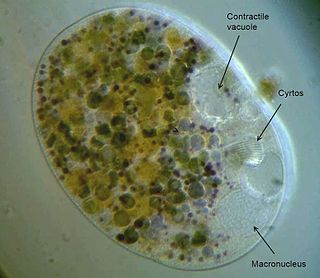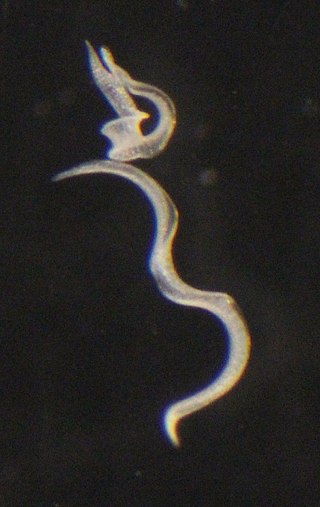
The heterotrichs are a class of ciliates. They typically have a prominent adoral zone of membranelles circling the mouth, used in locomotion and feeding, and shorter cilia on the rest of the body. Many species are highly contractile, and are typically compressed or conical in form. These include some of the largest protozoa, such as Stentor and Spirostomum, as well as many brightly pigmented forms, such as certain Blepharisma.

Blepharisma is a genus of unicellular ciliate protists found in fresh and salt water. The group includes about 40 accepted species, and many sub-varieties and strains. While species vary considerably in size and shape, most are easily identified by their red or pinkish color, which is caused by granules of the pigment blepharismin.

Nassula is a genus of unicellular ciliates, belonging to the class Nassophorea. Like other members of the class, Nassula possesses a basket-like feeding apparatus made up of cytopharyngeal rods (nematodesmata), which are themselves composed of closely packed microtubules. Nassula use this structure to ingest filamentous cyanobacteria, drawing individual strands of blue-green algae through the cytopharynx and into the body of the cell, where they are digested. As the algae are broken down, they can take on a variety of bright colours, which give Nassula a distinctive, variegated appearance under the microscope.
Karyorelictea is a class of ciliates in the subphylum Postciliodesmatophora. Most species are members of the microbenthos community, that is, microscopic organisms found in the marine interstitial habitat, though one genus, Loxodes, is found in freshwater.
Loxodes is a genus of karyorelictean ciliates, belonging to family Loxodidae. It is the only known karyorelictean ciliate that lives in freshwater habitats.

Lacrymaria is a genus of ciliates. Its best known species is the "Tear of Swan", Lacrymaria olor.

Frontonia is a genus of free-living unicellular ciliate protists, belonging to the order Peniculida. As Peniculids, the Frontonia are closely related to members of the genus Paramecium. However, whereas Paramecia are mainly bacterivores, Frontonia are capable of ingesting large prey such as diatoms, filamentous algae, testate amoebas, and even, in some circumstances, members of their own species. In bacteria-rich saprobic conditions, Frontonia leucas can live as a facultative bacterivore.

Condylostoma is a genus of unicellular ciliate protists, belonging to the class Heterotrichea.

Loxodidae is a family of karyorelict ciliates.
Remanella is a genus of karyorelict ciliates, belonging to family Loxodidae. Whereas Remanella inhabits brackish and marine waters, Loxodes – the other loxodid genus – is a freshwater taxon.
Protoheterotrichida is an order of karyorelict ciliates. It contains the family Geleiidae.
Geleiidae is a family of karyorelict ciliates. It is sometimes synonymized with family Aveliidae.

Kentrophoros is a genus of ciliates in the class Karyorelictea. Ciliates in this genus lack a distinct oral apparatus and depend primarily on symbiotic bacteria for their nutrition.
Wilbertomorphidae is a family of karyorelictean ciliates. The family is monotypic, because it contains a single genus Wilbertomorpha with a single known species, Wilbertomorpha colpoda.

Licnophora is a genus of ciliates in the family Licnophoridae. They typically have an hourglass-like shape and live as ectocommensals on marine animals.

Tracheloraphis is a genus of ciliates in the family Trachelocercidae.
Parduczia is a genus of karyorelict ciliates in the family Geleiidae.
Gellertia is a monotypic genus of karyorelict ciliates in the family Geleiidae. It contains a single species, Gellertia heterotricha.
Corlissina is a genus of karyorelict ciliates in the family Geleiidae. Only the type species Corlissina maricaensis is assigned to this genus.
Holosticha is a genus of littoral ciliates.









